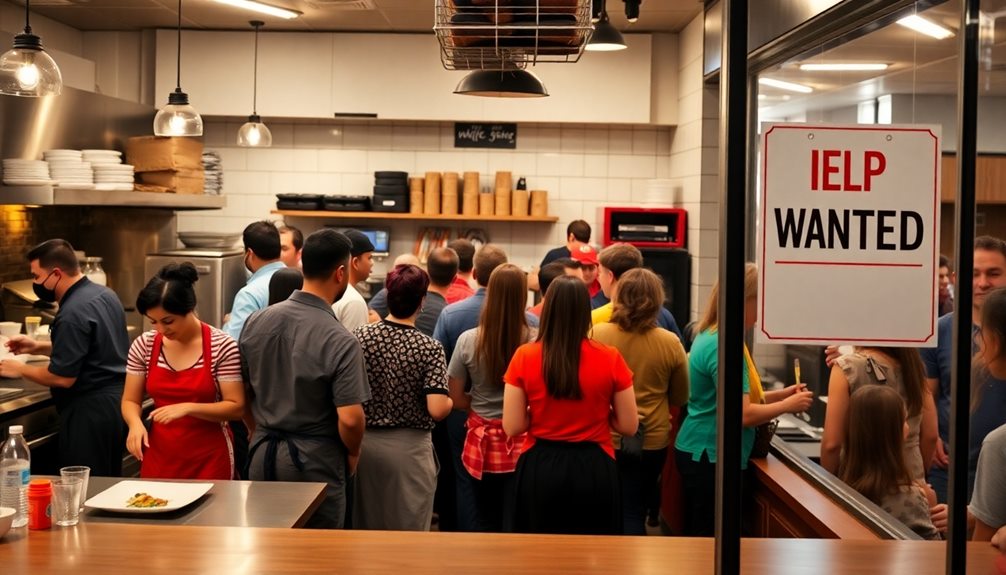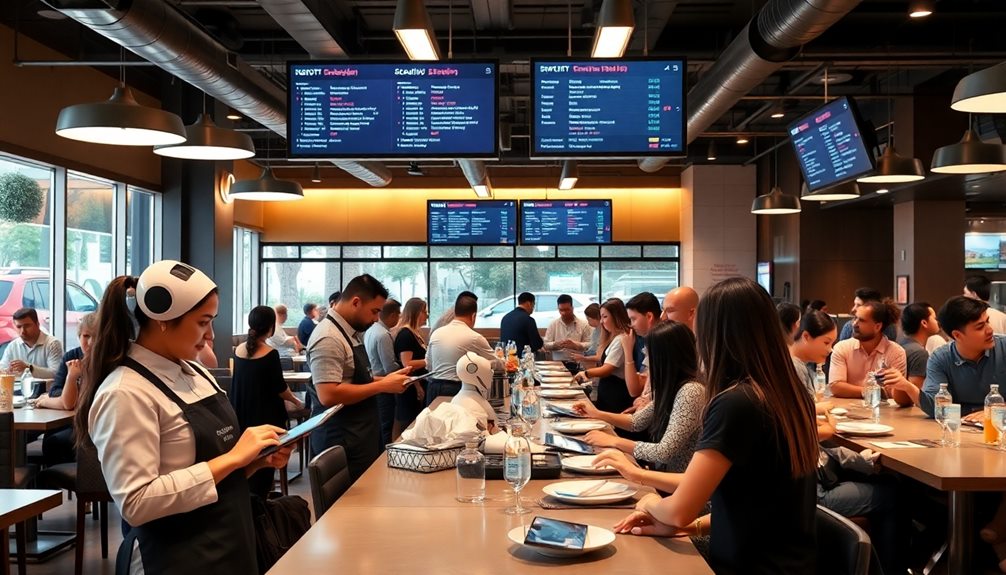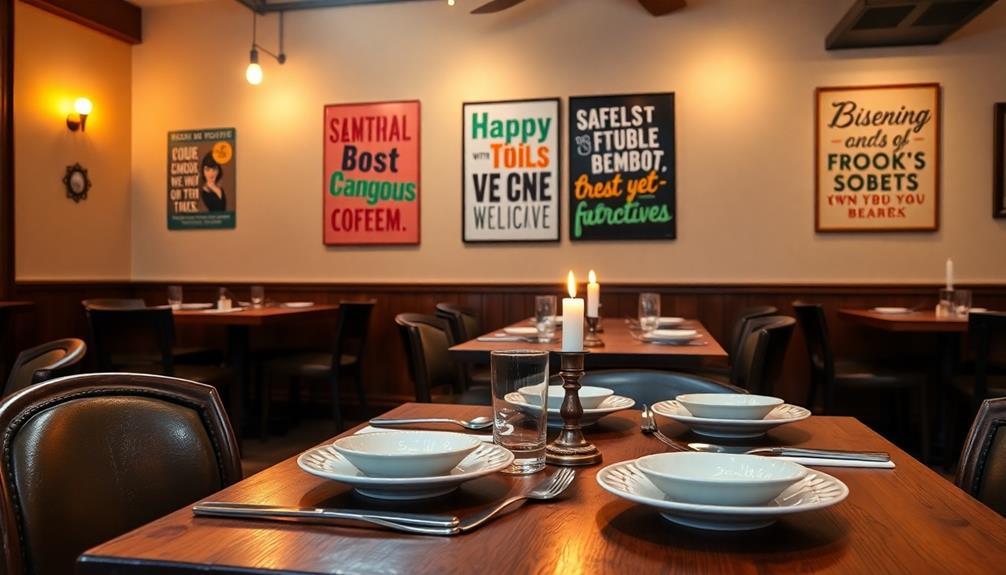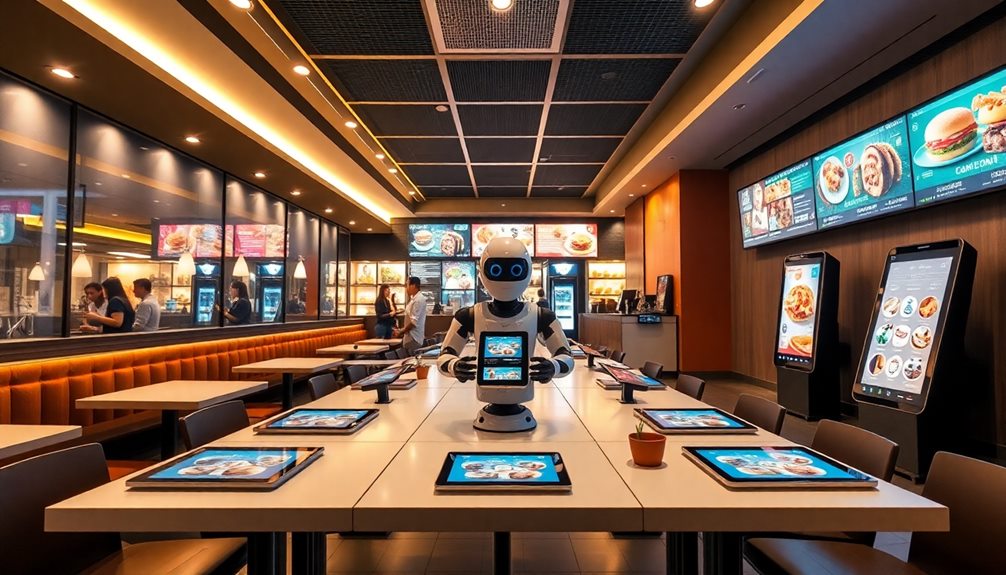The restaurant industry is booming, expecting to add 200,000 jobs in 2024. You'll find that many operators face challenges, with 45% experiencing staffing shortages. Turnover rates for hourly workers are high, hitting 135%, which can cost you about $2,305 per replacement. Yet, 66% of operators are still hiring, highlighting the competition for talent. Embracing diversity is essential too, as 35% of new hires are African American, improving workplace morale. Leveraging technology for scheduling and recruitment is becoming increasingly crucial. Want to know how these trends can impact your strategy? There's more to uncover.
Key Takeaways
- The restaurant industry is projected to add 200,000 jobs in 2024, emphasizing significant workforce demand.
- A turnover rate of 135% for hourly roles highlights major staffing challenges in limited-service restaurants.
- Diverse hiring practices are essential, with 35% of new hourly hires being African American, reflecting a push for inclusivity.
- Technology plays a crucial role, with 90% of operators using digital tools for efficient scheduling and hiring processes.
- The cost to replace an hourly worker is estimated at $2,305, underlining the financial impact of high turnover rates.
Industry Growth and Workforce Demand

The restaurant industry is on the rise, with a projected addition of 200,000 new jobs in 2024, driven by an increasing consumer appetite for dining experiences. This growth reflects a significant demand for restaurants, as total employment in the sector is expected to reach 15.7 million.
However, approximately 45% of restaurant operators report struggling to meet this demand due to workforce shortages.
As you explore job openings in the industry, you'll notice that operators are increasingly relying on technology for recruitment and training to tackle staffing challenges. It's vital to focus on employee retention strategies to guarantee that your team remains engaged and committed.
With sales projected to exceed $1 trillion, optimizing your workforce will be imperative for operational efficiency.
Despite this optimistic outlook, keep in mind that 38% of restaurants experienced unprofitability last year. This highlights the need for strategic staffing and careful management of your resources.
Employment Trends and Challenges

As the restaurant industry continues to expand, understanding employment trends and the challenges that come with them is essential for operators. In 2024, the industry is set to add 200,000 new jobs, reflecting the ongoing demand for staff. However, many restaurant operators face significant hurdles in recruiting employees. Job openings in the sector have dropped to 927,000, illustrating the difficulties in filling positions despite the desire to hire.
| Key Metrics | Statistics |
|---|---|
| Turnover Rate (Hourly Roles) | 135% in Limited-service |
| Hiring Plans | 66% of Operators Hiring |
| Employment Levels | 37,000 above Pre-pandemic |
| Job Openings | 927,000 |
The high turnover rates, particularly in hourly roles, indicate a persistent retention issue within the industry workforce. Nearly two-thirds of operators still seek to expand their staff, even with 45% acknowledging challenges in recruitment. Steering through these employment trends is crucial as operators endeavor to meet customer demands while building a stable, committed workforce.
Compensation and Turnover Insights

Steering compensation trends is essential for restaurant operators aiming to reduce turnover and retain talent. In the restaurant industry, base salaries for general managers rose by 2.2% year-over-year, complemented by an impressive 11.7% increase in annual bonuses. This led to an overall compensation growth of 3.1%, which is crucial in a landscape where compensation remains the leading reason for job changes among hourly workers.
However, the turnover rate for hourly roles in limited-service restaurants has soared to 135% in Q3 2024, underscoring the challenges of employee retention. With the cost to replace an hourly worker reaching approximately $2,305, the financial impact of high turnover is significant for your bottom line.
Moreover, management turnover has also seen a troubling rise, increasing from 45% to 55% since 2019. This instability in leadership positions can further exacerbate retention issues, making it essential for you to focus on competitive pay structures and benefits.
Diversity and Inclusion in Hiring

Creating a diverse and inclusive workforce is no longer just a trend; it's a necessity for restaurant operators who want to thrive in today's competitive market. In 2024, 35% of new hourly hires in the restaurant industry are African American, 5% are Asian, 26% are Hispanic, and 34% are white. This diversity not only exceeds U.S. population statistics but also reflects a broader commitment to inclusive hiring practices.
Awareness of narcissistic behaviors in workplace dynamics can also help foster a healthier environment, allowing for more equitable treatment of all employees.
When your management teams mirror the diversity of your hourly employees, you're likely to see improved performance in traffic and sales. This connection highlights how essential it's to prioritize diversity in hiring. Ongoing efforts to enhance representation in management roles can greatly boost workforce satisfaction and employee retention rates.
Today's consumers increasingly gravitate toward businesses that promote inclusivity, making it critical for restaurant operators to adapt. By focusing on diverse hiring practices, you'll not only foster a more vibrant work environment but also improve overall workplace morale.
Ultimately, building a diverse workforce isn't just good for business; it's essential for creating a thriving restaurant that meets the evolving expectations of both employees and customers.
Technology's Role in Staffing

The push for diversity in hiring is reshaping not just workforce dynamics but also how restaurants approach staffing overall. As an operator, you're likely feeling the pressure to meet customer demand while managing your team effectively.
Thankfully, technology is stepping up to help you address these challenges. With 90% of restaurant operators now using digital tools for scheduling and hiring, it's clear that tech-driven staffing solutions are becoming the norm. These digital tools enhance efficiency, allowing you to allocate staff resources better and streamline operations.
For instance, integrating handheld devices and automated systems can greatly improve service delivery and operational flow.
Moreover, the rise of accounting software—now used by 52% of restaurateurs—demonstrates a shift towards leveraging technology for payroll and staffing management. This shift not only simplifies processes but also boosts recruitment efforts.
By employing data-driven strategies, you can enhance your ability to attract and retain top talent, ensuring your restaurant stays competitive in a rapidly evolving landscape.
Embracing technology in your staffing approach is no longer optional; it's essential for success in today's restaurant industry.
Frequently Asked Questions
Why Are Restaurants Having Trouble Staffing?
You're facing staffing troubles because of high turnover rates, rising labor costs, and challenges in finding qualified employees. These issues make it tough to meet customer demand and maintain a stable workforce in your restaurant.
Is the Restaurant Industry Growing or Declining?
The restaurant industry's on the rise, showing significant growth potential. With sales projected to exceed $1 trillion and millions of jobs expected to be added, it's clear that demand and optimism are strong.
What Percentage of Restaurants Are Understaffed?
Did you know nearly 45% of restaurant operators struggle with understaffing? That means a significant number of restaurants can't meet customer demand. If you're in the industry, it's vital to address staffing challenges effectively.
Why Are Restaurants Struggling in 2024?
You're noticing that restaurants are struggling in 2024 due to high turnover rates, recruitment challenges, and rising labor and food costs. These factors make it tough for operators to meet customer demand effectively.
Conclusion
As you navigate the evolving landscape of restaurant staffing, remember that the industry mirrors a dynamic dance, where every step counts. Embracing trends like diversity and tech innovations can help you not just survive but thrive. By addressing challenges head-on and offering competitive compensation, you're not just filling positions—you're building a resilient team ready to face the future. So, take a cue from the masters of the dance: adapt, evolve, and lead with intention.









